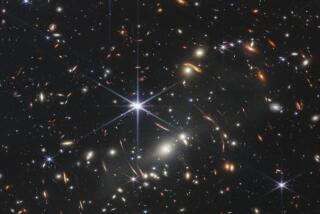BOOK REVIEW : Hounding Heavens for Clues to Cosmos : THE LIGHT AT THE EDGE OF THE UNIVERSE: Leading Cosmologists on the Brink of a Scientific Revolution <i> by Michael D. Lemonick</i> ; Villard Books/Random House $24, 314 pages
- Share via
Socrates made his students study astronomy to prepare their minds for the greater challenge of philosophy. If he were alive today, he might reverse the assignment, for the heavens, once thought to be an elegant symphony of sun and planets, have proven to be at least as complex and difficult to grasp as the most involved Socratic ethic.
Cosmologists have all but proven that the universe started with an almost inconceivably powerful explosion some 15 billion years ago. When theorists first proposed the radical idea--as an alternative to the then-reigning “steady state” theory--that the universe expanded from a tiny kernel of space and time, a doubting astrophysicist mockingly dubbed the hypothesized event the “Big Bang.” The catchy name stuck.
Having accepted that the Big Bang happened, cosmologists are now trying to account for almost unimaginably large structures in the universe, like immense bubbles whose skins are made of galaxies numbering in the millions. The scientists are also trying to calculate whether the universe will expand forever or eventually run out of energy and collapse on itself in a “Big Crunch.”
As reported in the new book by Time magazine science writer Michael Lemonick, these scientists’ calculations depend on huge quantities of something no one has ever seen: so-called dark matter.
It must exist, the scientists say, as the gravitational glue holding together the visible universe, which is otherwise simply too light to operate the way it does. Astrophysicists argue fiercely over the makeup of dark matter, but they agree on one point, Lemonick says: The mysterious stuff constitutes about 90% of the universe.
If the scientists are right, and nine-tenths of the universe turns out to consist of something other than what makes up ordinary stars, planets and people, we’re in for a devastating psychological shock, says Joel Primack, a leading dark-matter theorist. For we’ll have to realize we’re a minor sideshow to the main cosmic event, whatever that proves to be.
The blow to our collective ego will be equal to the one the Renaissance astronomer Copernicus dealt to the Church, and thus to Western culture, when he showed conclusively that the Earth revolved around the sun, instead of the reverse, UC Santa Cruz Prof. Primack says.
Some important recent discoveries support the far-out notions of Primack and other leading cosmologists, Lemonick reports. For example, researchers recently pieced together how galaxies began to form, a question that has long vexed astrophysicists.
Observing the sky with a satellite designed to study the Big Bang’s leftover radiation, the team found what they believe are the seeds of today’s galaxies. “It’s like seeing God,” said UC Berkeley astrophysicist George Smoot, the team’s leader.
Smoot’s public announcement of the discovery, in April, 1992, at a conference at Princeton’s Institute for Advanced Study, provides a neat end to Lemonick’s excellent “The Light at the Edge of the Universe.”
The fast-paced book--the author’s first--covers much of the same territory as Time colleague Dennis Overbye’s “Lonely Hearts of the Cosmos.” Both cosmologist-groupie authors peregrinate halfway around the world pursuing the 20-odd astronomers and astrophysicists who compose the leading edge of cosmology. Both books unfold in constant motion, from observatory to observatory, conference to conference and office to office.
“Light” offers the advantage of a last-minute chapter devoted to Smoot’s important discovery. But Lemonick as a traveling companion is less boon than the relatively gonzo Overbye. In fact, Lemonick fits the nerdy scientist stereotype better than do many of the researchers he interviews. Example: Two astronomers invite Lemonick to join them for a drink at a seedy watering hole, warning him that the patrons “sometimes have fistfights.”
“I wasn’t thrilled with the idea,” Lemonick writes, “but I went along . . . (and) warily drank my Perrier out of a beer mug.”
All right, so Michael D. Lemonick isn’t Hunter S. Thompson. But he’s nevertheless a trustworthy reporter and an inspiring explainer of some of the most mind-expanding ideas in contemporary cosmology.
More to Read
Sign up for our Book Club newsletter
Get the latest news, events and more from the Los Angeles Times Book Club, and help us get L.A. reading and talking.
You may occasionally receive promotional content from the Los Angeles Times.










